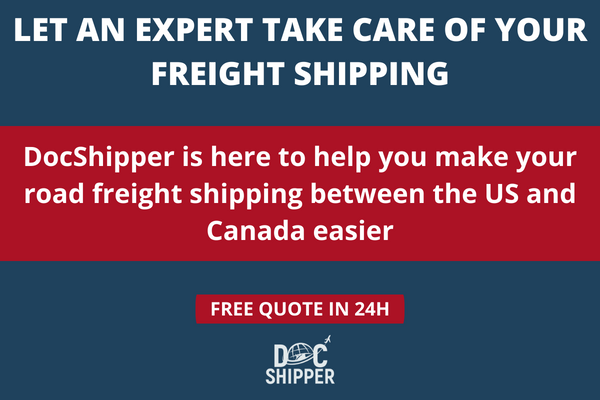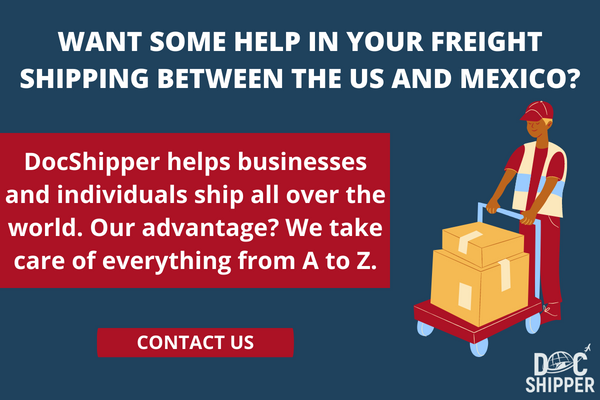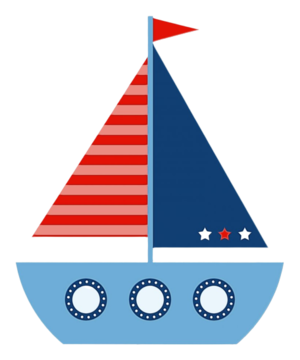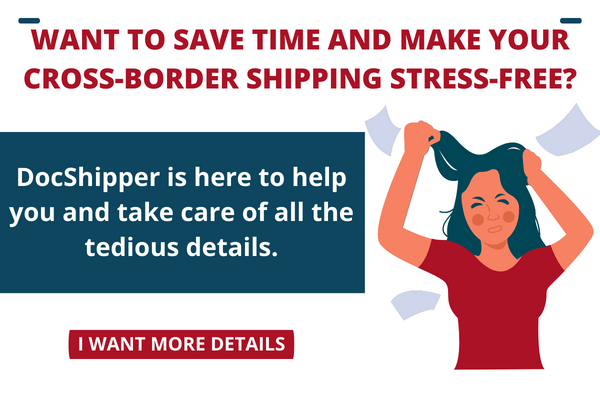Before we dive into the main topic, it is important to emphasize the importance of the United States borders. The US and Canada have the longest international border in the world. With a border length of 5,525 miles and 120 land ports of entry, the United States and Canada have one of the world's strongest and most extensive bilateral relationships.
Every day, goods and services worth close to $2.6 billion are traded between the two nations. As for the Mexican-American border, 3,145 kilometers comprise the entire continental border (1,954 mi). With about 350 million recorded crossings each year, the border between Mexico and the United States is the most frequently crossed border in the entire world.
While shipping freight from Canada to the United States is easy, with the only requirement having a valid Canadian passport, the same can not be said for the US-Mexico border. That being said, cross-border freight is extremely common at both borders.
Cross Border Freight Shipping between the U.S. and Canada
Freight shipping between the two North American nations is a tedious process. FedEx and UPS dominate the shipping market, but there are other options for small firms that carry pallets. Working with the appropriate transportation firm makes it easy to understand LTL shipping to the U.S. from Canada.
As of 2019, Canada is second only to Mexico in terms of importance as a commercial partner for the United States. Over $525 billion USD worth of imports and exports pass between the two nations every year, and 68% of that cross-border freight is transported by truck.
Road freight shipping between the U.S. and Canada
Even though it frequently happens, as nearly 30,000 trucks cross the U.S.-Canada border daily, moving freight across borders is more difficult than doing so domestically. Before shipping, you should set up a reputable customs broker(We will talk more about the customs broker later).
It is also important to have an importer of record, which will be indicated on the customs documents and is responsible for processing any duties payable to the U.S. or Canadian government. The importer of record can be either the seller or the buyer.
Of course, road freight shipping can also be done by car. It is important to note that vehicles may be imported duty-free into the United States by Canadians who do not reside there for up to a year for personal use. You should schedule your arrival to coincide with the arrival of your automobile if you are transporting it to the United States.
As always, DocShipper is here to help with your road freight shipping, so do not hesitate to contact us.
Air freight shipping between the U.S. and Canada
Of course, it is well known that air freight is a very dependable and fast method of transportation between any two nations. In the case of the US and Canada, it is very helpful if you want to ship from a state (in the case of the US) or a province (in the case of Canada) that is very far away from the American-Canadian border.
And while any industry can use air freight, as it is convenient and simple, there are particular sectors that frequently use air freight, and these are:
- Pharmaceutical businesses
- Automobile and aerospace technologies.
- Producers of computers and mobile devices.
- Suppliers of military equipment.
If you want any help with air freight shipping between the US and Canada, you can contact us.
Sea freight shipping between the U.S. and Canada
There are two types of sea freight: FCL(Full container load) freight and LCL(Less than container load) freight. The first type allows you to fill complete containers with your goods to transport for a set charge, and you are free to fill them however full you need to. The second type fills a complete container with your products and those of other businesses, which ships organize by box and pallet.
Just like there are certain industries that frequently use air freight, there are certain sectors that use sea freight transportation. These sectors are:
- the oil and gas sector.
- producers of raw materials, such as coal and grain.
- automobile and equipment manufacturers.
- makers of apparel and textiles.
If you want any help with sea freight shipping between the US and Canada, do not hesitate to contact us.
Freight Shipping between the U.S. and Mexico
It is difficult to move cargo between the US and Mexico. One of the biggest trading partners of the United States is Mexico. Over $600 billion worth of commodities, including automobiles, machinery, electronics, consumer goods, pharmaceuticals, and other items, flow across our southern border annually. And a truckload is used for 83% of that cross-border freight transportation.
Road freight shipping between the U.S. and Mexico
Almost 35,000 trucks cross the American-Mexican border daily, and even though it happens frequently, it is more complicated than domestic freight. There are three main differences between shipping at the southern border and shipping at the northern border and these are:
Leaving a package at the customs broker:
The U.S. carrier will unload the trailer at the customs broker's facility on the American side of the border when shipping south. Prior to passing, a Mexican customs inspector will physically inspect the cargo at the facility, removing the old seal and replacing it. Whether you are transloading or transporting through-trailer, this is true. Shipments headed north will often drop in the carrier's yard.
Mexican truck drivers do not typically have visas to enter the United States:
Your trailer will virtually always be transported across the border by a different crossing driver.
The transfer will take place at the customs broker's facility if you are transloading:
The customs broker assists with the physical examination and has knowledge of cross-docking. You probably won’t use a different facility.
As always, DocShipper is here to assist you in your road freight shipping between the U.S. and Mexico, so contact us if you are interested.
Air freight shipping between the U.S. and Mexico
As usual, it is worth mentioning that air freight is the fastest and most dependable means of transportation, and it is very helpful if you want to ship from a state that is very far away from the American-Mexican border. Air freight is ideal if you want to ship a small number of goods. There are 2 types of air freight: Classic air freight, which makes it possible to ship goods across the globe with no delays. This type of air freight enables the use of conventional airlines to deliver commodities. The second type of air freight is the express air freight which involves transporting goods through significant international corporations, also known as "courier businesses".
Do you want help with your air freight shipping between the U.S. and Mexico? Please contact us.
Sea freight shipping between the U.S. and Mexico
As previously stated, there are two types of sea freight: FCL and LCL. As expected, shipping durations between the US to Mexico vary depending on where exactly you are in the US or Mexico. For example, in case you choose LCL shipping from the Port of Miami to the Port of Veracruz, the transit time will be 13 days. When it comes to choosing between LCL shipping and FCL shipping, it depends on your consignment's size and nature.
LCL shipping is typically used by businesses when:
- Their shipment is modest—less than 14 cubic meters
- In Mexico, their cargo is not urgently needed.
- They don't mind if their products are housed in a container among other, unidentified commodities.
- Due to concerns over safety and/or cost, they cannot use air freight.
Although shipping to Mexico via LCL is generally the most economical option for smaller shipments, there are certain drawbacks to it. LCL shipments to Mexico can take longer than FCL shipments since the procedure necessitates the consolidation and deconsolidation of goods-logistical demands.
LCL shipping is typically avoided by businesses when:
- Their products are delicate, perishable, or expensive.
- Their goods may become damaged if they are moved or handled frequently.
- Delivery delays are unacceptable.
- They cannot share a container because their shipment is too enormous, heavy, or oddly formed.
FCL is frequently the best alternative for ocean shipment for companies that:
- Are sending a significant shipment, a minimum of 14 cubic meters
- Demand that their products arrive in Mexico by a certain date
- Need to carry fragile or large items
- Would like their container to be sealed before being shipped to Mexico and to have it remain sealed until it is delivered to the intended recipient.
DocShipper can help you with your sea freight shipping between the U.S. and its southern neighbor, so feel free to contact us.
Complete Customs Broker Services
Customs brokers are skilled professionals who ensure that all foreign shipments adhere to the rules set forth by the U.S. Customs and Border Protection (CBP) agency. A competent broker will simplify the procedure considerably and assist you in avoiding fines and expensive delays. They are also in charge of acquiring the licenses, permits, and other paperwork required to make it easier for commodities to travel. In order to ensure that your products are declared accurately and pass customs as fast and efficiently as possible, customs brokers are crucial.
It is important to know that the criteria for entering goods into the U.S. are that:
- Shipments costing more than $2,500 need a customs broker (any value if the shipment is controlled goods).
- In the case of shipments with a value of less than $2,500, the customs broker is not necessary.
The paperwork you need to clear customs in the USA
The following customs documents are commonly needed to import products into the US:
Bill of lading:
This document gives the driver and carrier all the necessary information they need to handle and properly bill the freight shipment, including the shipper's address and contact data as well as a description of the products being transported, including their size and weight.
Commercial invoice:
a detailed bill of sale that specifies the imports being made and their price.
Certificate of origin:
a document confirming the country of origin of the imported products.
Import declaration:
The main document used to report products and calculate the tariffs, taxes, and other fees owed to the United States government.
Entry summary:
a record that lists the items being imported, their worth, and the tariffs, taxes, and other fees that must be paid.
Packing list:
a thorough list of the items being imported, detailing their number, weight, and measurements.
Hazardous Materials Declaration (for hazardous goods):
a document that lists the class, division, and identification number of the dangerous commodities being imported.
The Road to Stress-Free Cross-Border Shipping with DocShipper
DocShipper can help you make cross-border shipping simple and stress-free and ensure that the import and export processes run easily, saving time and lowering the likelihood of issues with customs. We offer these services:
- FCL service (full container 20 feet or 40 feet)
- service that regulates temperature (cold, frozen and heated)
- committed service (a dedicated DocShipper consultant)
- Services for transshipment and warehousing
- safety measures (new fleet, GPS, TAPA)
FAQ | Cross Border Freight in the U.S.
Does DocShipper offer Cross Border transport services?
DocShipper provides tailored cross-border transport services that help businesses expand their reach in today's global economy. Our end-to-end logistics solutions, including customs brokerage and documentation support, ensure fast and reliable delivery of goods across borders. With our extensive network of over 40 nations and experienced freight forwarding professionals, we offer personalized advice and support to help your business succeed in new markets.
What is the cheapest way to ship to Canada from USA?
The cheapest way to ship to Canada from the USA depends on factors such as shipment size, urgency, and destination. International shipping companies like DHL or FedEx offer ground, air, or ocean freight for small packages, while ground shipping or LTL freight can be more cost-effective for heavier or larger items. Express shipping options are available for faster delivery, but are generally more expensive. It's important to compare prices among different carriers to find the most cost-effective shipping option for your needs.
What is the cheapest way to ship to Mexico from USA?
Many elements, including shipment size, urgency, and destination, affect how cheaply something can be shipped from the US to Mexico. For small items, international shipping firms like DHL or FedEx provide several shipping alternatives like ground, air, or ocean freight. LTL freight may be more cost-effective for heavier or larger items. For a quicker arrival, express or expedited shipping options are available, however they are typically more expensive. Finding the best affordable shipping option for your needs requires comparing costs across various carriers.
Do I need a customs Broker to ship Cross Border freight?
While not technically required, we highly recommend working with a customs broker to ensure the smooth and timely clearance of your cross-border freight. Customs regulations can be complex and ever-changing, and a skilled broker can simplify the process, help you avoid fines and delays, and ensure all necessary documentation is in order. At DocShipper, our licensed customs brokers provide the guidance and support you need to navigate the complexities of cross-border shipping, ensuring on-time and on-budget delivery.
DocShipper U.S. | Procurement - Quality control - Logistics
Alibaba, Dhgate, made-in-china... Many know of websites to get supplies in Asia, but how many have come across a scam ?! It is very risky to pay an Asian supplier halfway around the world based only on promises! DocShipper offers you complete procurement services integrating logistics needs: purchasing, quality control, customization, licensing, transport...
Communication is important, which is why we strive to discuss in the most suitable way for you!









